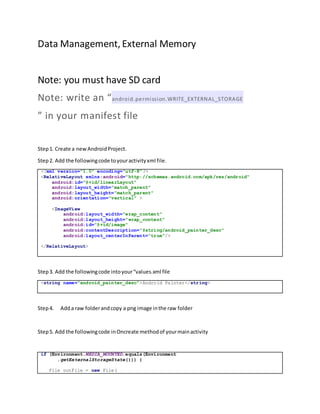3. file external memory
- 1. Data Management, External Memory Note: you must have SD card Note: write an âandroid.permission.WRITE_EXTERNAL_STORAGE â in your manifest file Step1. Create a newAndroidProject. Step2. Add the followingcode toyouractivityxml file. <?xml version="1.0" encoding="utf-8"?> <RelativeLayout xmlns:android="http://schemas.android.com/apk/res/android" android:id="@+id/linearLayout" android:layout_width="match_parent" android:layout_height="match_parent" android:orientation="vertical" > <ImageView android:layout_width="wrap_content" android:layout_height="wrap_content" android:id="@+id/image" android:contentDescription="@string/android_painter_desc" android:layout_centerInParent="true"/> </RelativeLayout> Step3. Add the followingcode intoyourâvalues.xml file <string name="android_painter_desc">Android Painter</string> Step4. Add a raw folderandcopy a png image inthe raw folder Step5. Add the followingcode inOncreate methodof yourmainactivity if (Environment.MEDIA_MOUNTED.equals(Environment .getExternalStorageState())) { File outFile = new File(
- 2. getExternalFilesDir(Environment.DIRECTORY_PICTURES), fileName); if (!outFile.exists()) copyImageToMemory(outFile); ImageView imageview = (ImageView) findViewById(R.id.image); imageview.setImageURI(Uri.parse("file://" + outFile.getAbsolutePath())); } Step6. Add The followingfunctionsinyourmainactivity private void copyImageToMemory(File outFile) { try { BufferedOutputStream os = new BufferedOutputStream( new FileOutputStream(outFile)); BufferedInputStream is = new BufferedInputStream(getResources() .openRawResource(R.raw.painter)); copy(is, os); } catch (FileNotFoundException e) { Log.e(TAG, "FileNotFoundException"); } } private void copy(InputStream is, OutputStream os) { final byte[] buf = new byte[1024]; int numBytes; try { while (-1 != (numBytes = is.read(buf))) { os.write(buf, 0, numBytes); } } catch (IOException e) { e.printStackTrace(); } finally { try { is.close(); os.close(); } catch (IOException e) { Log.e(TAG, "IOException"); } } } Step7. Done.


![getExternalFilesDir(Environment.DIRECTORY_PICTURES),
fileName);
if (!outFile.exists())
copyImageToMemory(outFile);
ImageView imageview = (ImageView) findViewById(R.id.image);
imageview.setImageURI(Uri.parse("file://" + outFile.getAbsolutePath()));
}
Step6. Add The followingfunctionsinyourmainactivity
private void copyImageToMemory(File outFile) {
try {
BufferedOutputStream os = new BufferedOutputStream(
new FileOutputStream(outFile));
BufferedInputStream is = new BufferedInputStream(getResources()
.openRawResource(R.raw.painter));
copy(is, os);
} catch (FileNotFoundException e) {
Log.e(TAG, "FileNotFoundException");
}
}
private void copy(InputStream is, OutputStream os) {
final byte[] buf = new byte[1024];
int numBytes;
try {
while (-1 != (numBytes = is.read(buf))) {
os.write(buf, 0, numBytes);
}
} catch (IOException e) {
e.printStackTrace();
} finally {
try {
is.close();
os.close();
} catch (IOException e) {
Log.e(TAG, "IOException");
}
}
}
Step7. Done.](https://image.slidesharecdn.com/3-171028182411/85/3-file-external-memory-2-320.jpg)